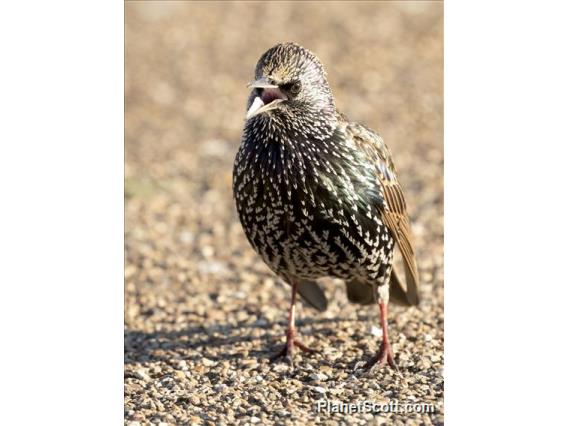European Starling (Sturnus vulgaris)

European Starling (Sturnus vulgaris)
×


European Starling (Sturnus vulgaris)
About European Starling (Sturnus vulgaris)
- Kingdom: Animals
- Phylum: Chordates
- Class: Birds
- Order: Perching Birds
- Family: Starlings and Mynas
The common starling, also known simply as the starling in Great Britain and Ireland, and as European starling in North America, is a medium-sized passerine bird in the starling family, Sturnidae. It is about 20 cm (8 in) long and has glossy black plumage with a metallic sheen, which is speckled with white at some times of the year. The legs are pink and the bill is black in winter and yellow in summer; young birds have browner plumage than the adults. Its gift for mimicry has been noted in literature including the Mabinogion and the works of Pliny the Elder and William Shakespeare.
Source: Wikipedia
Lifelists
Trips
Visits
-
1995-06-15
Mission - My Backyard, United States of America -
2005-12-02
Candlestick Park, United States of America -
2006-03-15
Chiemsee, Germany -
2006-03-23
Sultan's Marsh Bird Paradise, Turkey -
2006-08-16
Salt Lake City, United States of America -
2007-01-01
Candlestick Park, United States of America -
2007-06-13
Atlantic City, United States of America -
2008-01-26
Heron's Head Park, United States of America -
2008-02-17
San Jose del Cabo - Estuary, Mexico -
2008-07-14
Moscow, Russia -
-
2009-05-08
Burnidge Forest Preserve, United States of America -
2009-06-01
Redwood Valley, United States of America -
2009-11-07
Pinnacles National Monument, United States of America -
2009-11-22
Palo Alto Baylands, United States of America -
2009-11-29
Heron's Head Park, United States of America -
2010-06-25
Elgin - Bluff Spring Fen, United States of America -
2011-05-25
Mission - My New Backyard, United States of America -
2011-11-19
Ferry Plaza, United States of America -
2012-07-09
Sax-Zim Bog, United States of America -
2012-07-10
I-94 Rest Stop, United States of America -
2012-08-12
Redwood Shores - Radio Road, United States of America -
2012-09-07
Heron's Head Park, United States of America -
2012-09-19
Sutro Heights--Baths / Land's End, United States of America -
2012-09-23
Heron's Head Park, United States of America -
2012-11-20
Sydney - Millennium Parklands, Australia -
2012-11-20
Bondi Beach Coastal Trail, Australia -
2012-12-02
Lake Merced , United States of America -
2012-12-13
Heron's Head Park, United States of America -
2012-12-16
Lake Merced , United States of America -
2013-03-01
Chiemsee, Germany -
2013-03-04
John Heinz NWR at Tinicum (IBA), United States of America -
2013-03-23
Coyote Point County Park--harbor and marsh, United States of America -
2013-03-24
Fort Mason, United States of America -
2013-03-30
Heron's Head Park, United States of America -
2013-04-14
Austin, United States of America -
2013-04-15
Balcones Canyonlands NWR--Refuge HQ (Travis Co.), United States of America -
2013-04-17
Matagorda County Birding Nature Center, United States of America -
2013-04-18
Galveston Island, United States of America -
2013-04-19
Bolivar Peninsula, United States of America -
2013-04-20
Attwater Prairie Chicken National Wildlife Refuge, United States of America -
2013-08-05
Heron's Head Park, United States of America -
2013-12-01
Heron's Head Park, United States of America -
2014-01-01
Heron's Head Park, United States of America -
2014-01-04
Golden Gate Park - San Francisco Botanical Garden, United States of America -
2014-01-11
Heron's Head Park, United States of America -
2014-01-14
Candlestick Park, United States of America -
2014-03-04
Chabot Regional Park, United States of America -
2014-03-08
Tule Elk State Reserve, United States of America -
2014-03-10
San Simeon SP, United States of America -
2014-03-15
Alemany Community Garden, United States of America -
2014-04-06
Delta Meadows State Park, United States of America -
2014-04-19
Fort Mason, United States of America -
2014-05-03
Glen Canyon Park, United States of America -
2014-05-26
Heron's Head Park, United States of America -
2014-06-01
India Basin Shoreline Park, United States of America -
2014-06-07
Sunol Regional Wilderness--Visitor Center area, United States of America -
2014-06-14
Peaarson-Arastradero Preserve, United States of America -
2014-06-22
Redwood Valley, United States of America -
2014-11-29
Lafayette Park, United States of America -
2014-12-27
Heron's Head Park, United States of America -
2015-01-01
Candlestick Park, United States of America -
2015-01-02
Pixley NWR, United States of America -
2015-01-03
Woodward Park, United States of America -
2015-01-04
Panoche Valley, United States of America -
2015-01-19
Lake Merced , United States of America -
-
-
-
-
-
-
-
-
-
-
-
-
-
-
-
-
-
-
-
-
-
-
-
-
-
-
-
-
-
-
-
-
-
-
-
-
-
-
-
-
-
-
-
-
-
-
-
-
-
-
-
-
-
-
-
-
-
-
-
-
-
-
-
-
-
-
-
-
-
-
-
-
-
-
-
-
-
-
-
-
-
-
-
-
-
-
-
-
-
-
-
-
-
-
-
-
-
-
-
-
-
-
-
-
-
-
-
-
-
-
-
-
-
-
2025-11-15
Hohnes Hill Nature Reserve, Australia -
2025-11-17
Western Treatment Plant, Australia -
2025-11-17
Lorne, Australia -
2025-11-19
Split Point, Australia -
2025-11-19
Royal Park Swamps, Australia -
2025-11-21
Royal Tasmanian Botanical Garden, Australia -
2025-11-25
Maria Island, Australia -
2025-12-01
Bendigo, Australia -
2025-12-04
Yarrawonga, Australia -
2025-12-04
Warby-ovens National Park, Australia -
2025-12-05
Milawa, Australia -
2025-12-05
Wangaratta, Australia -
2025-12-08
Mallacoota Sewage Ponds, Australia





